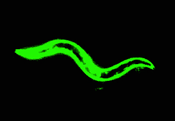
Research that makes people laugh and then think
 Caenorhabditis elegans |
Caenorhabditis elegans hungry - fantastic story  The human brain (Homo sapiens - Homo sapiens) contains 86 billion nerve cells - neurons and 100 trillion processes - synapses. Understanding this complex economy is almost impossible. At the same time, the brain of the simplest worm, a nematode (Caenorhabditis elegans - elegant fouling), consists of only 302 neurons. A free-living nematode is such a round worm with a length of about 1 mm; the whole worm consists of 959-1031 cells, depending on sex. The worm is small, non-parasitic, has a short life cycle, approximately 3.5 days at 20 degrees. Specialists from Australia, Canada and the University of Massachusetts, USA, decided to start with the simplest worm and gradually get closer to the secrets and mysteries stored in the secret depths of the human brain. At the level of the simplest worms, it is already possible to investigate the patterns of work of some chains of a highly organized nervous system. So the scientists decided. Specialists investigated the reactions of simple worms to external stimuli, while looking through a microscope at the reaction of nerve cells in experimental specimens. Modern technologies make it possible to see the occurrence of a nerve impulse and its movement along the nervous system Caenorhabditis elegans both for a single neuron and for the entire system as a whole. Researchers studied the worm’s nervous system when it moves and when it is motionless, when it encounters obstacles and when it goes around obstacles, when it eats and when it digests food. High-precision systems recorded every event, every impulse and any change that occurs under the microscope. "We are almost related to these same worms," Roy Worming, professor of biology at the University of Massachusetts, told BBC reporters. "We almost slept with them, we almost ate with them, and everything else. Honestly, if God created something standing on the earth, then it is undoubtedly the worms of Caenorhabditis elegans". An obvious and convincing achievement of the international team of scientists was that they deciphered the thoughts of their wards by 89.9%. There were two of them. The first and main idea sounds something like this: I really want to eat! The second thought of the simplest worm can be expressed by the cry of "Guard!" Researchers continue their painstaking work. In 2016, they are going to attract the largest universities in Germany and England to research. Their goal is to decipher the thoughts of the worms of the species Caenorhabditis elegans one hundred percent. One of the assumptions that has not yet been confirmed is the possibility of having a third thought in the remaining ten percent with a penny, presumably this thought of the following content - "Oh!"
Источник - пресса |
| (c) 2010-2024 ig-nobel.ru | ig-nobel@mail.ru |

